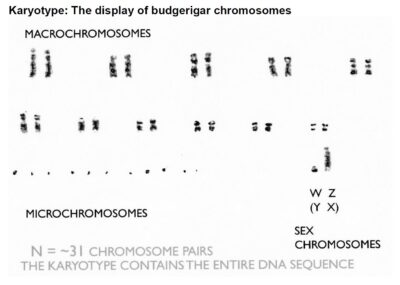
Genetics in Budgerigars
Budgerigars are one of the most popular and beloved pet birds in the world. Their beautiful colors and playful nature make them a joy to own and breed. However, to breed budgerigars, it’s important to understand the basics of their genetics. Here, we’ll discuss the three main types of budgie genes: dominant genes, sex-linked genes, and recessive genes. 
Dominant Genes in Budgerigar Genetics
Dominant genes express themselves even if there is only one copy present in a bird’s DNA. Therefore, if a bird has one dominant and one recessive gene for a trait, it expresses the dominant gene. For example, the Dominant Pied gene is responsible for the bird’s markings. A bird with only one copy of this gene will still have the markings on its feathers, flights and tail. Varieties that are dominant in their mode of inheritance, such as the Grey factor (Grey and Grey Green), Spangle, and others, are very easy to reproduce.
Sex-Linked Genes in Budgerigar Genetics
Genes located on the sex chromosomes (X and Y) inherit differently in males and females are known as sex-linked genes. Budgerigars have one pair of sex chromosomes, with females having one X and one Y chromosome. Conversely, males have two X chromosomes. To this point, this is the opposite in humans. This means that a female budgie can only inherit sex-linked genes from its father, while a male can inherit sex-linked genes from both parents.
One example of a sex-linked gene in budgerigars is the Cinnamon-wing gene. A Cinnamon-wing cock can only breed Cinnamon-wing hens. The exception to this is when the cock is split for Opaline or another factor. In this case, he can breed a mixture of Cinnamon-wing and Opaline Cinnamon-wing hens. If a breeder pairs a male Cinnamon-wing bird with a Spangle hen, they can breed Spangle Cinnamon hens and/or Cinnamon wing hens. They cannot produce normal hens since the cock is Cinnamon, even though the hen is carrying the dominant Spangle gene.
To reproduce sex-linked varieties such as Texas Clearbody, Lutino, Albino, Cinnamon wing, Lacewing, and Opaline, a male bird must carry that gene to produce females of that variety. However, to produce a visual male, both the male (in the split form or visually) and female (must be visual for that variety as she cannot be split) need to carry the gene. In budgerigars, only a male can hide a sex-linked gene.
Recessive Genes in Budgerigar Genetics
Birds express a recessive gene only when both copies are present in their DNA. If a bird carries one dominant gene and one recessive gene for a specific trait, it expresses the dominant gene while hiding the recessive gene. To express the grey wing gene in chicks, both parents need to carry it. Unlike sex-linked genes, both parents can carry recessive genes.
Conclusion
Understanding budgerigar genetics is essential for successful breeding. Breeders can predict the traits expressed in their offspring by understanding the basics of dominant genes, sex-linked genes, and recessive genes. Dominant genes express themselves even if there is only one copy, while both copies of recessive genes must be present. Males and females inherit sex-linked genes differently since these genes are located on the sex chromosomes.
When breeding budgies, it’s important to select breeding pairs carefully and keep records of their genetic makeup. This can help you make informed decisions when picking breeding pairs and predicting the traits in their chicks. By understanding budgerigar genetics, you can continue to produce healthy, beautiful, and diverse budgies for years to come.
